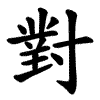對
- to face;
- to respond;
- counterpart;
It evolved to mean “to face, to respond, to match, to oppose,” and is widely used in both classical and modern terms, including technical “anti-” usages in Korean and Chinese.
Etymology
對 depicts a hand holding an object (丵), originally meaning “to face or handle something.”
Ideogram:
Composed of 丵 (착, “dense vegetation or object”) and 寸 (촌, “hand/measurement”).
Represents holding something shaped like 丵 in the hand.
Meaning development:
There are several interpretations of what 丵 originally depicted:
A writing tablet (suggesting “to write and respond”) – Lin Yiguang, 文源
A lampstand (implying “to hold up a light and face something”) – Zhu Fangwei, 殷周文字釋叢
A toothed weapon (symbolizing confrontation) – Gao Hongjin, 中國字例
Because of the uncertainty over 丵’s exact meaning, the precise origin of 對 is debated.
Usage in Korean
Today 對 is used for ideas of “facing,” “responding,” or “opposing.”
Appears in very common words like:
對答 (대답) – “to reply”
相對 (상대) – “relative, counterpart”
對應 (대응) – “to correspond, to match”
In modern contexts, it conveys “counter-” or “anti-” in technical terms:
對空砲 = anti-aircraft gun
對戰車 = anti-tank
對人地雷 = anti-personnel mine
Words that derived from 對
- 대(對)–versus
- 대답(對答)–answer; reply
- 대립(對立)–opposition; confrontation; conflict
- 대상(對象)–target; subject
- 대응(對應)–response; correspondence
- 대작(對酌)–drinking together
- 대전(對戰)–competition; match; battle
- 대조(對照)–comparison; contrast
- 대치(對峙)–confrontation; standoff
- 대항(對抗)–opposition; resistance; match
- 댓글(對글)–comment
- 반대(反對)–opposite; contrary; opposition; objection
- 삼대상기준(三對象基準)–communion of three object partners
- 삼대상목적(三對象目的)–three object purpose
- 상대(相對)–facing each other; fighting with; comparison
- 상대기대(相對基臺)–foundation for reciprocation
- 상대기준(相對基準)–common base
- 상대방(相對方)–counterpart; the other person
- 상대적(相對的)–being relative
- 상대적 관계(相對的 關係)–reciprocal relationships
- 상대편(相對便)–the other party; counterpart
- 상대하다(相對하다)–face each other; fight with
- 적대(敵對)–being hostile
- 적대국(敵對國)–enemy state
- 적대시(敵對視)–antagonization
- 적대심(敵對心)–hostility
- 적대자(敵對者)–opponent
- 절대로(絕對로)–ever
- 절대자(絕對者)–the Absolute; supreme being
Alternative forms
対
- 廿土木戈 (TGDI)
- ⿰⿱ 业 𦍌 寸
